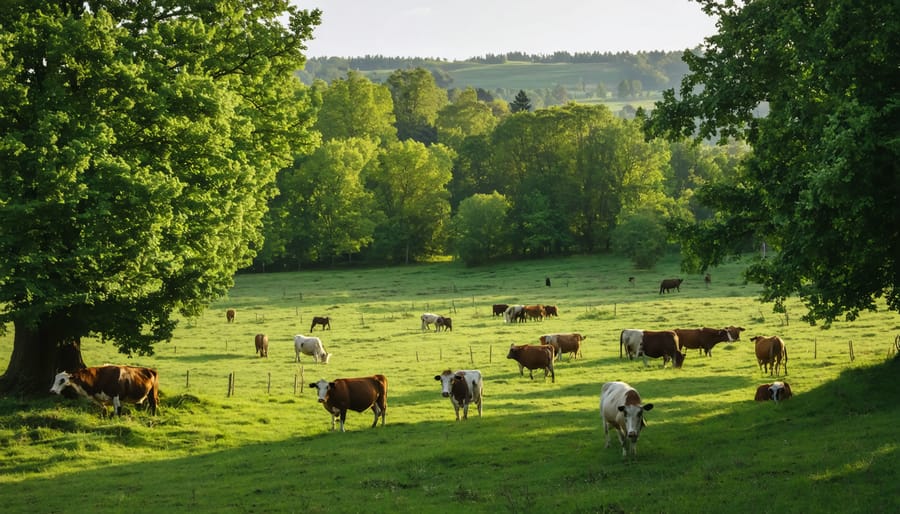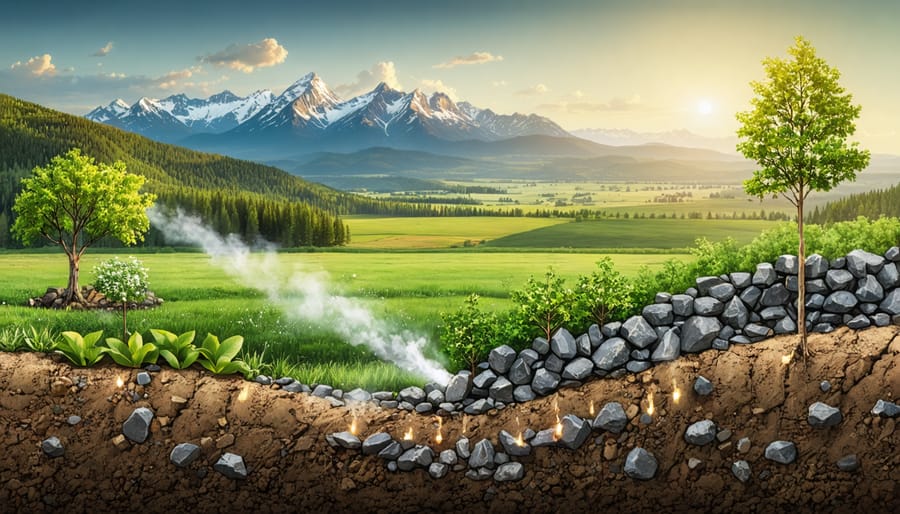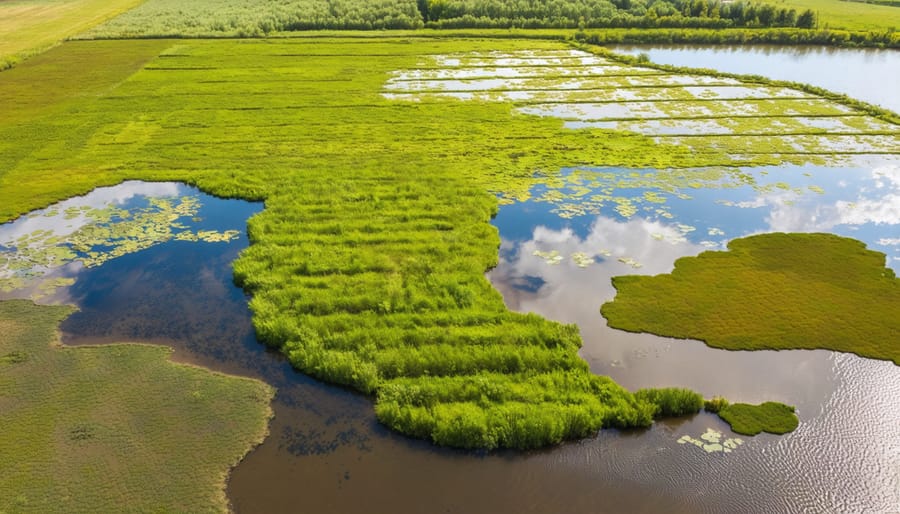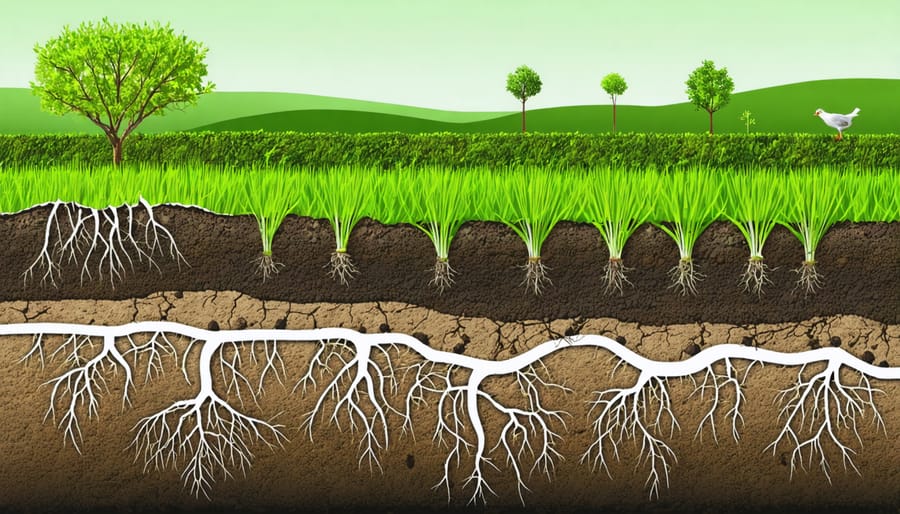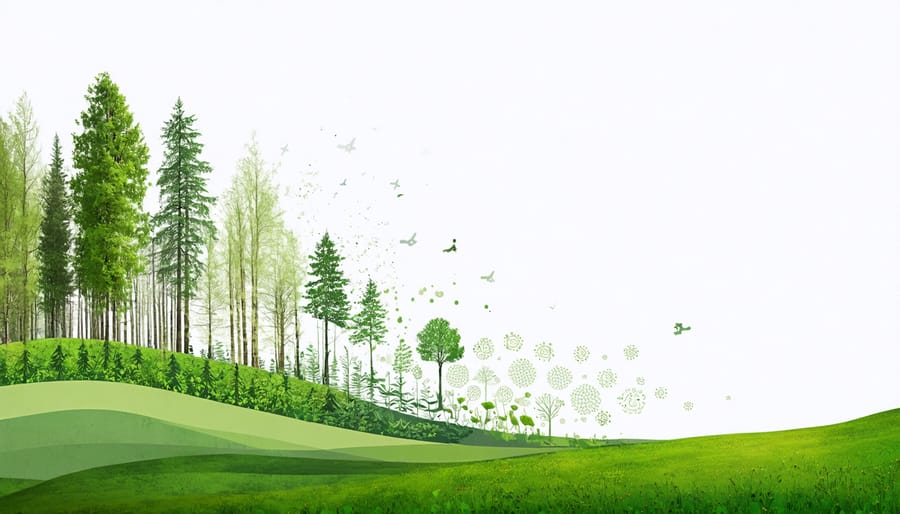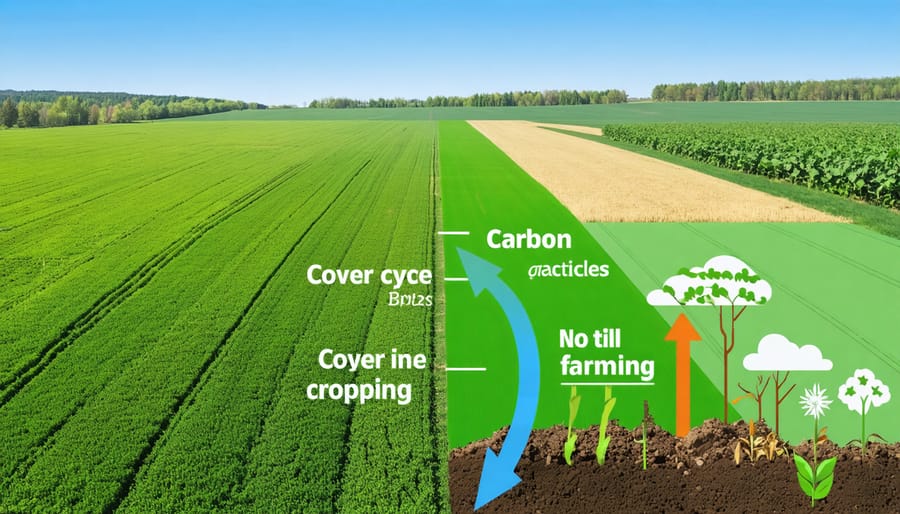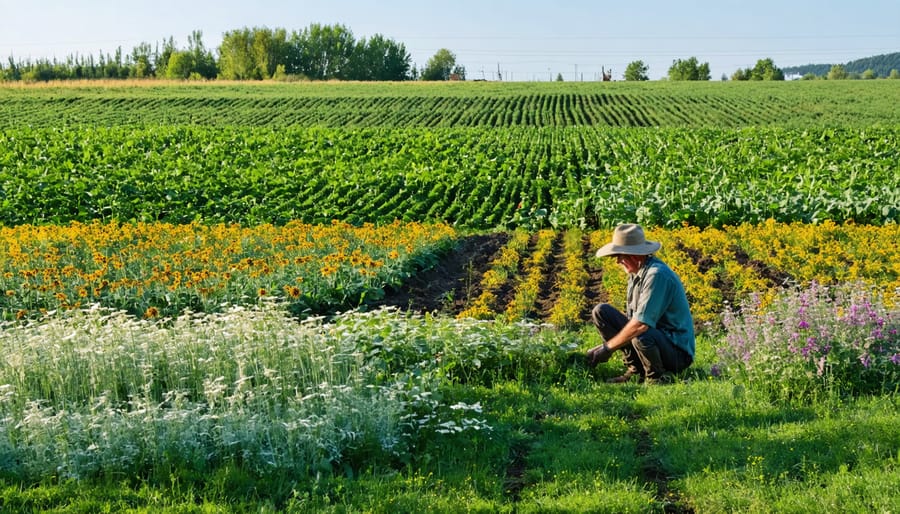As ocean temperatures rise, innovative carbon sequestration strategies in our oceans offer promising solutions for Canadian agriculture. The world’s oceans naturally absorb nearly 30% of global carbon emissions, acting as Earth’s largest carbon sink. By enhancing these natural processes through specialized farming techniques and marine ecosystem restoration, Canadian coastal communities can play a crucial role in climate change mitigation.
Ocean carbon sequestration combines traditional knowledge with cutting-edge science, allowing farmers and coastal operators to capture and store atmospheric carbon dioxide in marine environments. From seaweed cultivation in British Columbia to integrated multi-trophic aquaculture in the Maritime provinces, these practices not only reduce greenhouse gas levels but also create sustainable income streams for agricultural communities.
For Alberta’s inland farmers, understanding ocean carbon sequestration provides valuable insights into developing complementary land-based practices. The interconnected nature of terrestrial and marine carbon cycles offers opportunities for collaborative approaches between coastal and inland agricultural sectors, strengthening Canada’s position as a leader in climate-smart farming solutions.
Understanding Ocean Carbon Sequestration
Natural Ocean Carbon Sinks
The oceans play a vital role in naturally capturing and storing carbon dioxide from our atmosphere – much like how our Prairie soil stores carbon. Two main processes work together to make this happen: the biological carbon pump and the physical carbon pump.
The biological pump starts with tiny marine plants called phytoplankton, which absorb CO2 during photosynthesis, similar to how crops take in carbon on our farms. When these organisms die, they sink to the ocean floor, taking the captured carbon with them. This process stores carbon in deep ocean sediments for hundreds or even thousands of years.
The physical pump works through ocean circulation patterns. Cold water at the poles can hold more CO2 than warm water, so as surface waters cool and sink, they carry dissolved carbon to the deep ocean. Think of it like cold storage for carbon. This natural system helps maintain the balance of CO2 in our atmosphere, much like how our agricultural practices can help store carbon in the soil.
These natural ocean processes store about 25% of human-produced CO2 emissions annually, showing just how important our oceans are in the global carbon cycle.
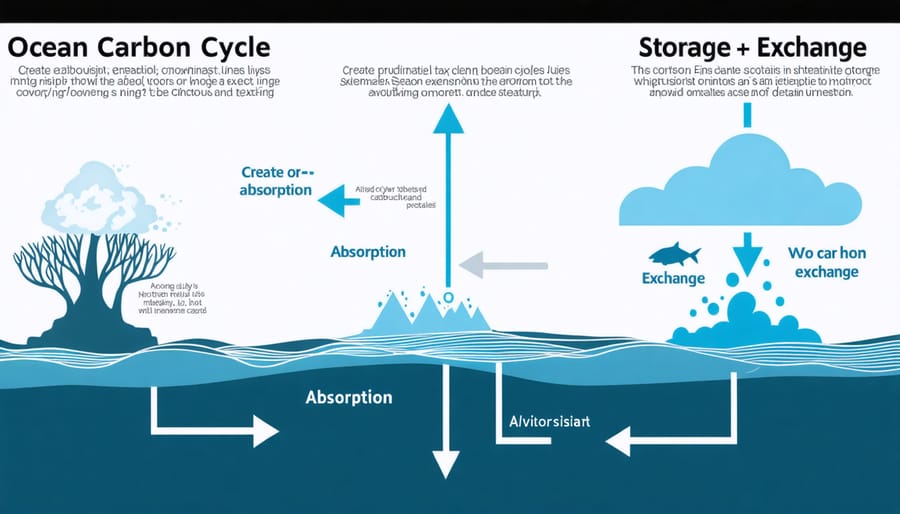
The Blue Carbon Connection
Just as our Prairie grasslands store carbon in their root systems, coastal ecosystems play a vital role in capturing and storing carbon dioxide from our atmosphere. These marine environments, including salt marshes, seagrass meadows, and mangrove forests, are incredibly efficient at sequestering what we call “blue carbon.” In fact, these coastal ecosystems can store up to five times more carbon per acre than our terrestrial forests.
For Canadian farmers, understanding blue carbon systems offers valuable insights into natural carbon storage processes. The way these coastal plants trap and hold carbon in their sediments mirrors how our agricultural practices can enhance soil carbon storage. These marine ecosystems demonstrate nature’s most effective carbon-storing techniques, which we can adapt for our own land management strategies.
Along Canada’s extensive coastlines, particularly in British Columbia and the Maritime provinces, these blue carbon ecosystems work tirelessly to help mitigate climate change. By protecting and restoring these coastal areas, we’re not only supporting carbon sequestration but also protecting our shorelines from erosion and creating wildlife habitats – benefits that parallel sustainable agricultural practices on our farms.
Key Ocean-Based Carbon Storage Techniques
Coastal Ecosystem Enhancement
Just as regenerative farming practices help store carbon in soil, coastal ecosystems play a vital role in capturing and storing carbon dioxide from our atmosphere. These marine environments, often called “blue carbon” ecosystems, are particularly effective at sequestering carbon for long periods.
Seagrass meadows, which can be found along Canada’s extensive coastlines, act like underwater prairies, trapping carbon in their root systems and surrounding sediments. These marine plants can store carbon up to 35 times faster than tropical rainforests, making them powerful allies in our climate efforts.
Mangrove forests, though less common in Canada, provide crucial lessons for ecosystem restoration. Their complex root systems not only store significant amounts of carbon but also protect coastlines from erosion and storm damage. While mainly found in warmer regions, their successful restoration projects offer valuable insights for Canadian coastal management.
Saltmarshes, which are more prevalent along Canadian shores, are particularly efficient carbon sinks. These coastal wetlands trap sediment and organic matter, gradually building up layers of carbon-rich soil. Recent restoration projects in Nova Scotia and British Columbia have shown promising results, with restored marshes sequestering substantial amounts of carbon while providing essential habitat for marine life and shore birds.
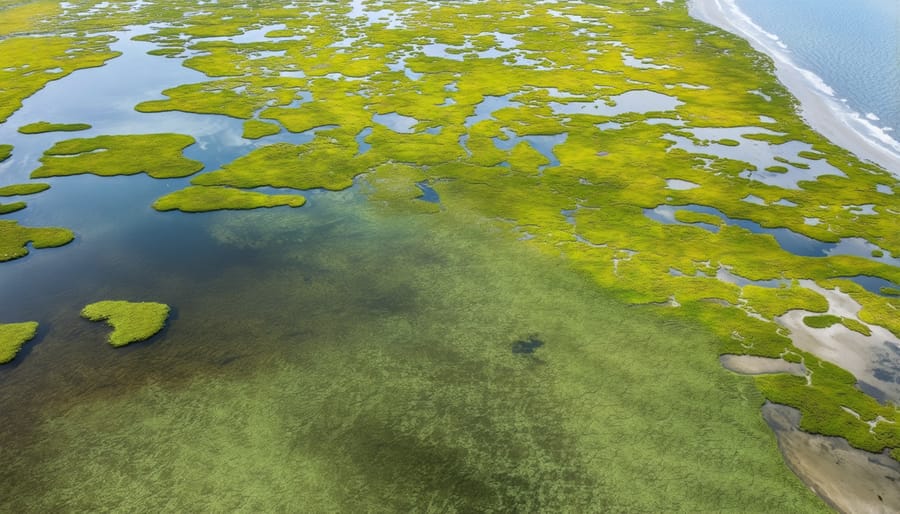
Ocean Fertilization
Ocean fertilization offers a fascinating approach to carbon sequestration by stimulating algal blooms in our oceans. This process works by adding iron or other nutrients to ocean waters, encouraging the growth of phytoplankton – tiny marine plants that naturally absorb carbon dioxide during photosynthesis.
When these nutrients are added to nutrient-poor ocean regions, they trigger rapid algal growth, similar to how we use fertilizers to boost crop yields on land. As these microscopic plants multiply, they pull significant amounts of carbon dioxide from the atmosphere. When the algae eventually die, they sink to the ocean floor, effectively storing the captured carbon in deep waters.
For our farming community, this concept mirrors familiar agricultural practices of nutrient management and crop cultivation, just on a marine scale. Canadian researchers have conducted several promising trials in the Pacific Ocean, where iron fertilization showed potential for large-scale carbon capture.
However, like any management practice, ocean fertilization requires careful consideration. Scientists are still studying its long-term effects on marine ecosystems and food chains. The technique’s efficiency varies depending on ocean conditions, much like how soil conditions affect crop outcomes.
While this method might seem removed from our prairie farming operations, understanding ocean fertilization helps us appreciate the broader picture of carbon management and how different ecosystems contribute to climate solutions. It’s part of the larger toolkit we’re developing to address climate challenges while maintaining productive agricultural systems.
Artificial Upwelling
Just as farmers use irrigation systems to bring water where it’s needed most, artificial upwelling works by pumping nutrient-rich deep ocean water to the surface. This process mimics natural upwelling, where ocean currents bring cold, nutrient-dense water up from the depths, supporting marine life and enhancing carbon dioxide absorption.
The technology typically involves large pipes or pumping systems that extend hundreds of meters below the surface. These systems can be powered by renewable energy sources like wave or wind power, making them environmentally sustainable. When the deep water reaches the surface, it stimulates phytoplankton growth, which, like crops on land, absorbs CO2 through photosynthesis.
For our farming community, this concept might sound familiar – it’s similar to how we manage nutrient circulation in sustainable agriculture. Just as we work to optimize soil nutrients for better crop yields, artificial upwelling enhances ocean productivity and carbon storage capacity.
Canadian researchers at the Ocean Networks Canada have been studying these systems off our Pacific coast. Their findings suggest that strategic placement of upwelling devices could significantly boost marine ecosystem productivity while capturing carbon. This technology shows promise as part of our nation’s broader carbon management strategy, complementing land-based agricultural practices that many of us already implement.
While still in development, artificial upwelling represents an innovative approach to carbon sequestration that draws on principles familiar to anyone working with natural systems.
Canadian Innovation in Ocean Carbon Storage
British Columbia’s Coastal Projects
British Columbia’s coastline has become a beacon of hope for carbon sequestration efforts, with several successful projects demonstrating the power of our marine ecosystems. The Cowichan Bay Estuary Restoration Project stands out as a prime example, where local farmers partnered with marine biologists to restore tidal marshes that now capture an impressive 1,800 tonnes of carbon annually.
In the Great Bear Rainforest region, indigenous communities have led initiatives combining traditional knowledge with modern science to protect and enhance kelp forests. These underwater carbon sinks not only store significant amounts of CO2 but also provide valuable habitat for marine life and help buffer ocean acidification.
The Vancouver Island Seagrass Conservation Project has successfully restored over 23 hectares of eelgrass meadows since 2019. These underwater prairies sequester carbon at rates up to 35 times faster than tropical rainforests, while also protecting shorelines from erosion – a benefit many coastal farmers have noticed in their adjacent agricultural lands.
What makes these projects particularly relevant for Alberta’s agricultural community is their innovative funding model. Through carbon offset programs, inland farmers can now participate in coastal carbon storage initiatives, creating additional revenue streams while contributing to climate solutions. Several Alberta grain producers have already partnered with coastal projects, demonstrating how land-based and marine conservation efforts can work together for mutual benefit.
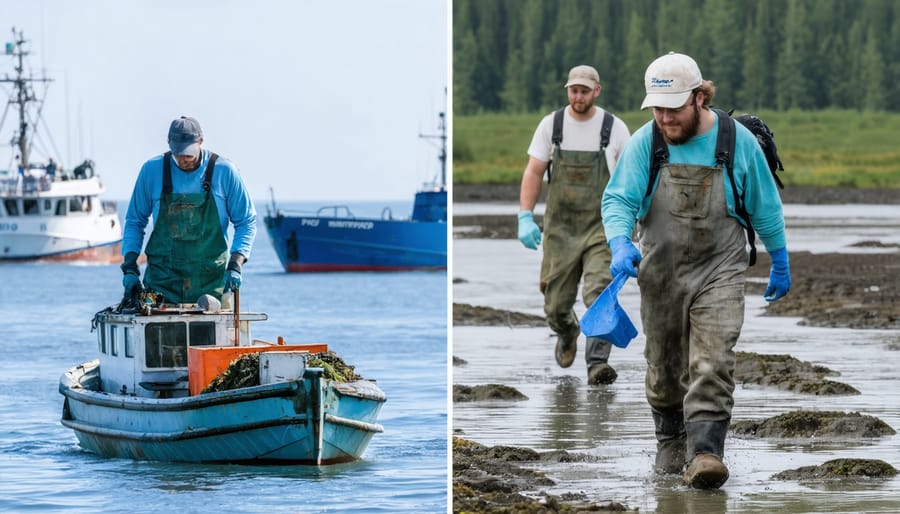
Alberta’s Connection to Ocean Solutions
While Alberta may seem far removed from ocean carbon initiatives, our prairie farmers play a crucial role in advancing climate change solutions through their agricultural practices and research contributions. The knowledge gained from soil carbon sequestration in Alberta’s farmlands has provided valuable insights for ocean carbon storage research, particularly in understanding how different ecosystems process and store carbon.
Alberta farmers are pioneering regenerative agriculture techniques that mirror natural ocean processes. For instance, the use of cover crops and minimal tillage practices helps us understand how organic matter breaks down and stores carbon, similar to how marine plants and organisms sequester carbon in ocean environments.
Local agricultural research stations, including the University of Alberta’s Department of Agricultural, Food and Nutritional Science, are collaborating with marine scientists to study carbon cycling patterns. This cross-ecosystem research has revealed surprising parallels between soil and ocean carbon storage mechanisms, leading to innovations in both sectors.
Alberta producers also benefit from this knowledge exchange. Understanding ocean carbon sequestration helps farmers adapt their practices to maximize carbon storage potential in their soils, while potentially opening new revenue streams through carbon credit programs that draw on both terrestrial and marine carbon storage principles.
Implementation and Future Opportunities
Partnership Opportunities
Canadian farmers have several opportunities to participate in ocean carbon storage initiatives through emerging partnership programs. The Pacific Carbon Trust and Ocean Farmers Alliance are actively seeking agricultural partners to join their collaborative efforts in British Columbia’s coastal regions. These programs offer farmers carbon credits for implementing practices that support marine ecosystem health and carbon sequestration.
Farmers can engage by participating in seaweed cultivation projects, where excess nutrients from agricultural runoff are redirected to support kelp forests. These partnerships typically involve training programs and technical support from marine scientists, making the transition accessible for land-based farmers interested in expanding their environmental impact.
Financial incentives include carbon offset credits, which can be traded or used to meet provincial emissions targets. The Canadian Agricultural Partnership (CAP) has also introduced grants specifically for farmers participating in ocean-linked carbon initiatives, with funding up to $75,000 per project.
To get started, farmers can connect with their local agricultural extension office or contact the Ocean Carbon Alliance of Canada, which maintains a database of active projects seeking agricultural partners. Regular workshops and information sessions are held throughout Alberta and British Columbia to help farmers understand and access these opportunities.
Economic Benefits
Ocean carbon sequestration presents significant economic opportunities for Canadian agricultural communities through emerging carbon markets. Farmers can potentially benefit from soil carbon credits and similar ocean-based credit systems, which are gaining traction in Alberta’s environmental markets.
Currently, carbon credit prices in Canada range from $50 to $65 per tonne, with projections suggesting increases to $170 per tonne by 2030. For farmers implementing ocean-linked carbon capture practices, such as seaweed-based feed additives or coastal buffer zone management, these credits represent a valuable additional revenue stream.
The Canadian government offers various incentives and support programs for agricultural operations engaging in carbon sequestration initiatives. The Agricultural Clean Technology Program, for instance, provides funding of up to $2 million for projects that reduce emissions and enhance carbon storage capabilities.
Local success stories include the Maritime Watershed Initiative, where coastal farmers have partnered with oceanographic researchers to develop integrated land-sea carbon management strategies, resulting in both environmental benefits and economic returns through carbon credit markets.
As we’ve explored throughout this article, ocean carbon sequestration presents both challenges and opportunities for Canadian agriculture. The ocean’s natural ability to store carbon offers valuable lessons for our farming practices, particularly in soil management and carbon capture techniques. By understanding these marine processes, we can better implement sustainable practices on our own farms.
For Alberta farmers, the connection between ocean carbon sequestration and agricultural practices highlights the importance of viewing carbon management as part of a larger ecological system. The principles we’ve discussed can be adapted to enhance soil carbon storage, improve crop yields, and potentially create new revenue streams through carbon offset programs.
Moving forward, we encourage you to take action by implementing some of the practices we’ve outlined. Start with soil testing to establish your baseline carbon levels, explore cover cropping techniques, and consider joining local agricultural networks focused on sustainable farming. Remember that every hectare of properly managed farmland contributes to Canada’s carbon reduction goals.
The agricultural community has always been at the forefront of environmental stewardship. By incorporating these insights from ocean carbon sequestration into our farming practices, we can continue this tradition while building more resilient and profitable operations for future generations.
Connect with your local agricultural extension office to learn more about available resources and support programs for implementing carbon-smart farming practices. Together, we can make a significant impact on Canada’s climate action goals while strengthening our agricultural sector.


